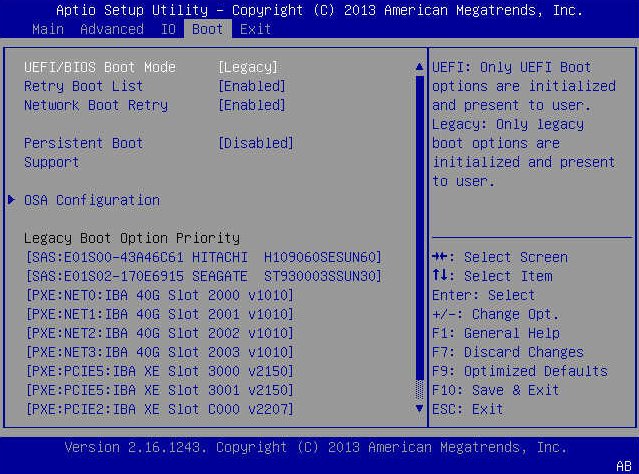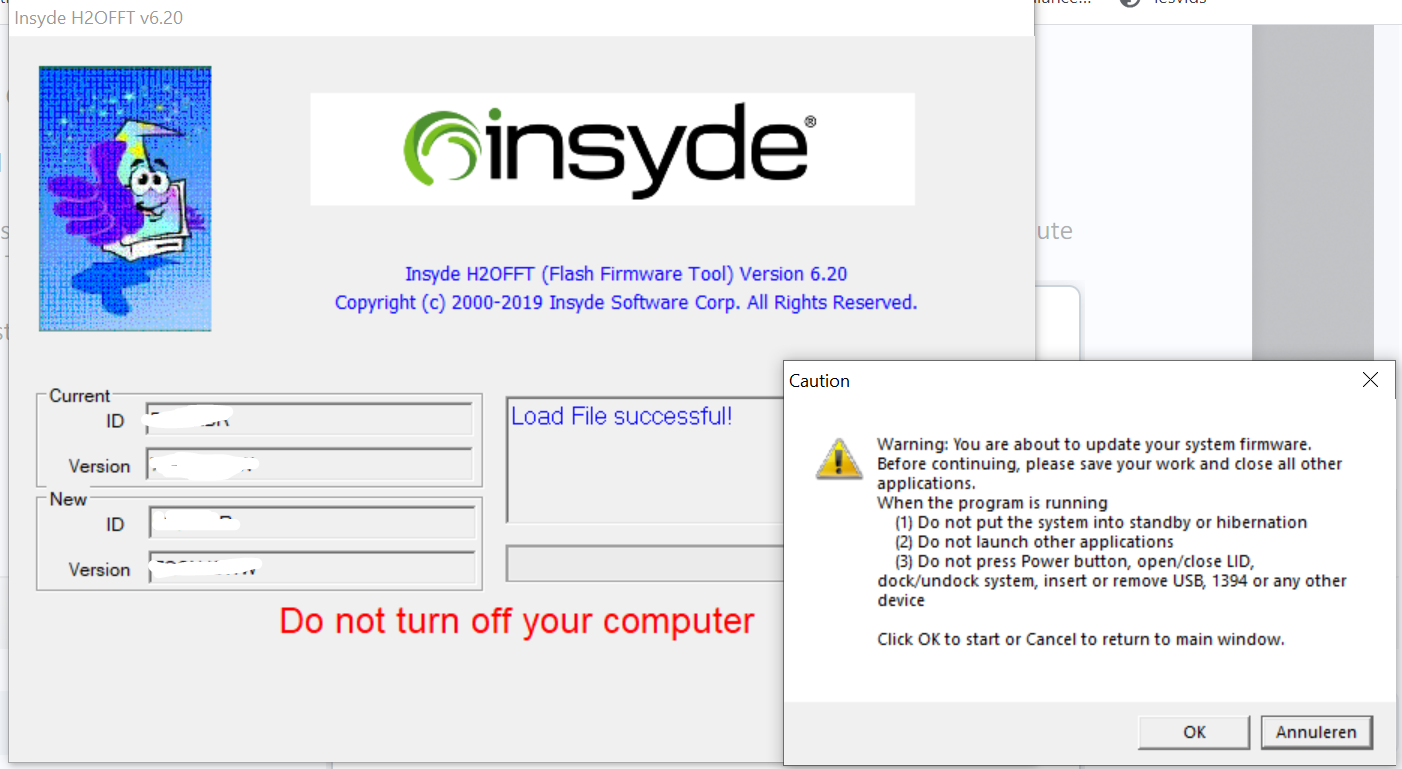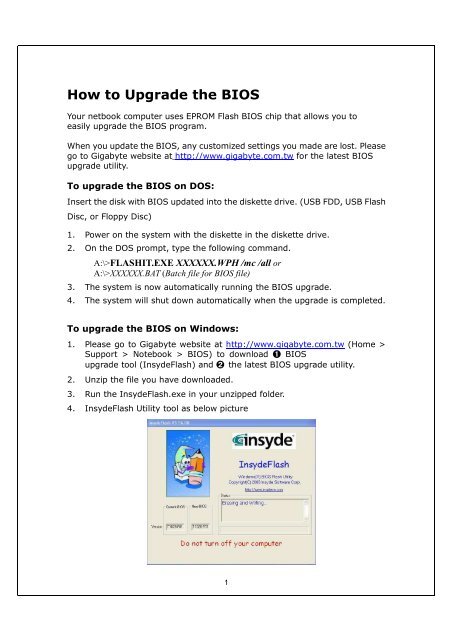Insydeflash Bios Utility How To Load Basic; Insydeflash Bios Utility Software Updates IF; Ive had Windows updates pop up for the past three days through Windows Update. Simply ask a new question if you would like to start the discussion again. It wasnt from HP. It had a blue bird logo and in my Programs it says it was from Insyde.
The problem with that is that the Dell utility used to flash the Insyde BIOS requires the system to reboot. Well, to reboot I have to do a full power discharge which in turns erases the BIOS image that the utility has pushed to memory somewhere.
InsydeFlash.exe Something wrong with InsydeFlash.exe? Is InsydeFlash.exe using too much CPU or memory? It's probably your file has been infected with a virus. Let try the program named to see if it helps. How to remove InsydeFlash.exe If you encounter difficulties with InsydeFlash.exe, you can uninstall the associated program (Start > Control Panel > Add/Remove programs What can you do to fix InsydeFlash.exe? Let try to run a system scan with Speed Up My PC to see any error, then you can do some other troubleshooting steps. To find out what is affecting PC performance If you think this is a driver issue, please try Where do we see InsydeFlash.exe?

Hi, I have a Dell Inspiron 7520 (i7 processor) laptop. When I tried to start my system it showed the spinning icon, and after few seconds, it showed me a blue screen with the following error message: ' Your PC ran into a problem and needs to restart. We're just collecting some error info, and then we'll restart for you'. Once it shows the above message, the system restarts and then repeats the same process of showing the same error message and restarting. This keeps happening in a loop. The software running in the BIOS is Insydeh20 setup utility. I managed to get a copy of Windows 8 on a USB drive.
- Dell 64BIT BIOS Flash Utility 3.3.1, A03 2020-01-16 158 KB Freeware Win 10 / 8 / 7 / Vista 4898 5 Dell 64BIT BIOS Flash Utility is intended to flash official Dell system BIOS directly from the command-line.
- Feb 13, 2017 Dell 64BIT BIOS Flash Utility Installation instructions Download the BIOS executable for the specific system that you are going to update and place it in a directory of your choice.
In order to boot from the USB, I got into the Bios (using F2) and tried to 'Add boot option,' as there were no other boot options present. When I tried to do that, it asked me to provide a name. I entered 'USB'. It then added it & allowed me to edit properties of this option. When I tried to edit the property, it asked for File system path. Because this is a USB drive, I do not have a clue as to what this value should be & how to set this USB drive as the first priority. Any instructions on how to set the file system path for the USB drive and how to set it as the first priority will be greatly appreciated.

Insydeh20 Bios Flash Utility Download
You need to create a UEFI specific boot USB drive to boot usb devices with a UEFI system. Some Dell models (like my new Inspiron 11) doesn't even have a legacy mode. 1) Disable UEFI secure boot (this is a key exchange that occurs for an installed system) 2) Create a UEFI enabled Windows OR Linux usb drive (MUST be formatted FAT16 or FAT32): Unbuntu: Windows 8: 3) When you boot, press F12. Individuals by pf strawson pdf to doc. If done correctly, it SHOULD show up as a bootable device. Just went through this crap tonight and randomly answering forums in hopes of saving other people from this headache! Ok seems it`s not fixed Step 1) Disable legacy protection if it has by entering your own password in BIOS, then disable legacy protection.
Step 2) Choice your way to fix this because there is 2 ways to fix this: Install Windows To Go on Flash drive and boot it from PC Laptop second way is use two flash drives one where is installation second flash drive is need to use for place OS like Windows 10,8,7,Vista,XP Linux, iOS etc. Step 3) If you choose version Windows To Go you need only one flash where to install it before it you need to get Software called Rufus at site:, after download it run and it will show drive to install choose your and select disc icon after that browse your selected ISO installation if it has Windows To Go Rufus will automatically show this option if it has, like almost all ISO downloaded from Microsoft, msdsn.microsoft.com etc. It will take long hours but you will get OS installation on any Flash drive where is enough free space, reboot PC laptop make sure USB flash drive is in first BOOT UP place set by BIOS. All OS is on your flash without any BOOT option straight by Rufus Step 4) If you choose version 2 flash drive version you need 1 flash with OS installation files like Windows 7 and 1 flash drive where to install it, you can use similar software Rufus to write in flash OS installation without checking Windows To Go version in Rufus this is fastest way to install OS.
When it`s start up Windows boot from flash installation you just need to choose drive like new 1 flash drive it will 100% install to it if you select it in installation time when installation is started. Step 5) Check Disk formation - if you ask about File system installation than you need to use program called Command prompt or CMD you must run as administrator this by making shortcut on Desktop by right mouse click on desktop->new->shortcut and locate your CMD like C: windows system32 cmd.exe, now on new made shortcut right click->properties->Shortcut tab->Advance->check Run as administrator->Ok->Ok now you have CMD with administrator rights. Now just open new shortcut->type diskpart-> hit enter-type list disk->hit enter->type select disk(your flash drive watch who it is like:1 now command to type looks like: select disk 1-> hit enter->list partition->select partition 1->Delete partition->create partition primary->Now go to my computer open Flash drive it will ask Format drive click on it, but remember files larger than 4GB need NTFS file system so use NTFS before formatting new flash drive->Click format.
Some time ago I bought an Alienware M14xR2 as my last laptop broke down. Lately, Alienware published an update for my BIOS that I can't burn in my computer because I only use Archlinux. By googling a bit I quickly found a tool for burning the BIOS in a DOS command line but I would need to have a look to the update package.
Just by executing the update file in a virtual machine in windows I soon figured out it was a self extracting package. I just searched %TEMP% files for the extracted version.
Ding.wav is just audio. I suppose it is played when flash is finished.Just by reading the header of the ini files we can guess they are configuration files for the flasher utility. The format is self explained in comments. In line 61 I found that the file I wanted for flashing was isflashWin.bin but after a fast attempt with FreeDOS and the tool I mentioned before I realised that the format was not FD as it should so I googled a bit more. As it turns out, Insyde has released a new update file format and as it seems it isn't documented.
Inside the file I found a section that is exactly the same as the configuration file and it is preceded by a string quite suspicious.
I think these headers separate sections of the file as they are all 16 characters long. By having a look inside Hexedit I found that there is a padding of 8 bytes between the last character and some famous file magic numbers. I've done a simple python script (filesplitter) for splitting this kind of files and continue the analysis.
Part number four is clearly the configuration file. If you are trying to tweak parameters in platform.ini note that it wont work, but if you modify this part of the binary file it will. It seems that Insyde is now using the platform.ini only to point to the update file (isflashWin.bin) and then the utility just parses the configuration from there.I had no success in running one and two. I've tried FreeDOS and Windows 98 in DOS mode which should have support for MZ executables but in the best case I got no output and in the worse some memory address exceptions.I found that number three is related to a utility called Flashrom but I don't have much time to investigate. Maybe some readers can point me in the right direction.After having a look to five in Hexedit I think it can be a BIOS image although I don't really know about this topic.


Although I could not flash my BIOS I could find some little information about this new format and I also found that MZ executable signatures weren't in the binary analysis tool I use (binwalk). The latest version of binwalk now looks for MZ executables.
Insyde Corp Bios Update

Please enable JavaScript to view the comments powered by Disqus.comments powered by